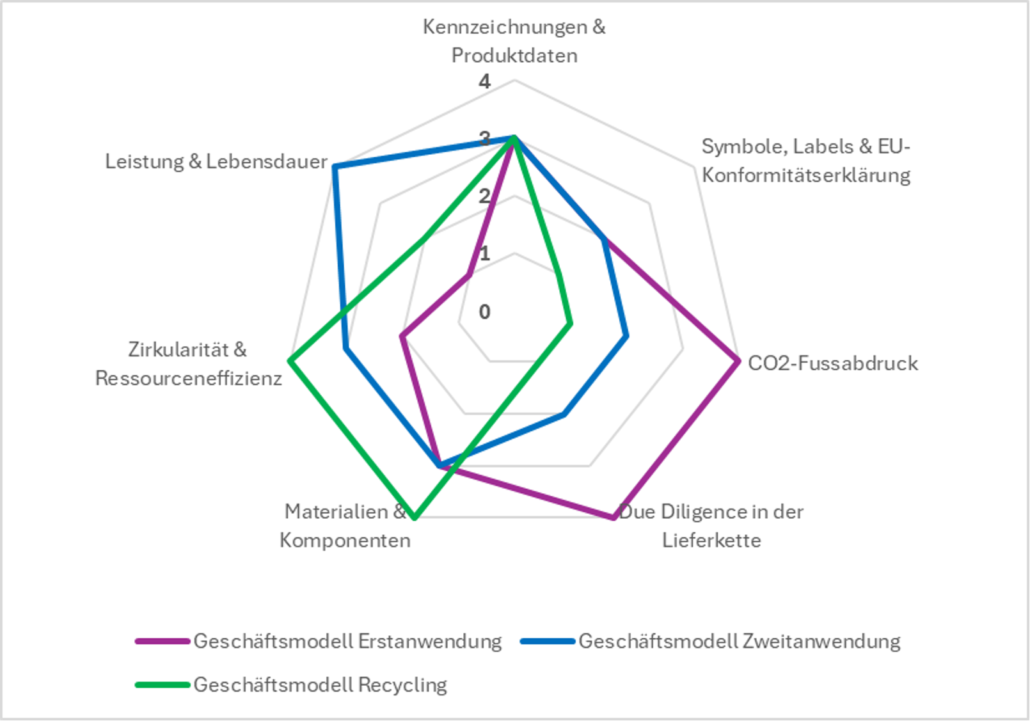How the digital product passport for batteries supports sustainable business models and thus promotes the circular economy
In 2027, the EU will introduce a digital product passport for batteries with a capacity above a certain level. All companies that use such batteries and operate in the EU will be affected by this regulation. As part of the new Battery Regulation (EU 2023), the digital battery passport is intended to help make the battery value chain more transparent to promote a sustainable circular economy. The aim of this article is to show which data contained in the battery passport is relevant for which business models.
Introduction
Since the Paris Climate Agreement (Consilium 2025) was signed in 2015, numerous countries have set climate neutrality (Europe 2025) as the central goal of their climate policy. This also applies to the European Union with the European Green Deal (Europe 2019) and to Switzerland with the Energy Strategy 2050 (SFOE 2025). To achieve these objectives, the decarbonization of motorized transport and implementation of the energy transition, that is, the transformation from an energy system based on fossil fuels to a system based on renewable energy sources, are particularly necessary. Batteries are one of the key technologies.
One key aspect is establishing a value chain for batteries in Europe that is as geopolitically independent as possible. The circular economy makes a decisive contribution to this, as it should enable the more efficient utilization of critical raw materials. The digital battery passport contributes to this goal by creating transparency in the battery industry and reducing information asymmetries between manufacturers, users, and recyclers. In this way, circular business models are promoted, which contributes to the long-term sustainability of the battery industry.
How does a battery passport work?
A digital battery passport is an electronic data record that transparently documents the entire life cycle of a battery, from production and use to recycling. The digital battery passport can be accessed via a QR code attached to the battery, which leads to the individual data of the respective battery; different information is available depending on access rights. The data in a battery passport are divided into the following categories (Battery Pass Consortium 2023):
- Labelling and product data
- Symbols, labels and EU Declaration of Conformity
- CO2 footprint of the battery
- Due diligence in the supply chain
- Battery materials and components
- Circularity and resource efficiency
- Performance and service life
While most data points in categories 1 to 5 are publicly accessible, access to data points in the other categories is subject to restrictions. This is reserved exclusively for persons with demonstrable legitimate interest, as well as competent authorities and the European Commission (Battery Pass Consortium 2023). To gain access to these data, companies must be registered as “person with a legitimate interest” by a government agency or the EU. These and other points remain unclear, as the detailed EU legislation is still being finalized.
Every economic operator who places batteries on the European Single Market is responsible for creating and maintaining a battery passport. This obligation covers the entire battery life cycle. This includes not only the first use, for example, in an electric vehicle, but also a possible second use, for example, as stationary energy storage in buildings, as well as recycling (see Figure 1). From 2027, the battery passport will be mandatory for the following battery categories (Battery Pass Consortium 2023):
- Batteries in light means of transport (e.g. in e-bikes and e-scooters)
- Industrial batteries with a capacity of over 2 KWh
- Batteries in electric cars
As a result of this regulation, Swiss companies are also subject to the requirements of the EU Battery Passport Regulation.

Figure 1: Responsibility for the battery passport along the value chain (Battery Pass Consortium, 2023, p. 52)
What does the battery passport mean for companies?
As shown in Figure 1, various business models along the value chain are affected by the introduction of a battery passport or can benefit from it, as more information on a specific battery is available as a result. In the following, selected business models are presented using the example of an electric car battery – both in terms of their responsibility and their benefits from the battery passport:
- Manufacturers: The business model of manufacturers, such as automotive groups, is based on the sale of vehicles – especially electric cars – to end customers. The responsibility for the battery passport remains with the manufacturer, while customers can only access publicly available data.
- Secondary application: If the battery has lost so much power that it can no longer be used in an electric car, it can still be used in other applications with lower requirements. A specialized company could convert the battery (or parts of it), for example, as stationary storage for buildings with photovoltaics. This company then brings the converted battery back onto the market and is therefore responsible for the battery passport. Here, too, the responsibility is not transferred to the user. The performance data in the battery passport for the first life of the battery (e.g., charging cycles and fast charging processes) are of particular interest to the company, as this helps with the conversion.
- Recycling: As soon as a battery has reached the end of its useful life after its second use, it is sent for recycling, which also transfers the responsibility for the battery passport to the recycling company. Access to detailed information on the materials contained and the chemical composition of the battery is particularly important for these stakeholders, as this enables efficient categorisation and further processing of various battery models.
It has not yet been clarified exactly how the transfer of responsibility for the battery passport will proceed in detail (labelled as “transfer case 1” and “transfer case 2” in Figure 1). Increased transparency will primarily strengthen sustainable business models at the end of the value chain, making batteries more recyclable.
A report by the Battery Pass Consortium on the data contained in the battery passport and an analysis of typical sustainable business models such as second use or recycling served as the basis for analysing the opportunities for sustainable business models. Based on this, we first analysed which actors disclose data in the battery passport and which actors retrieve this information (see Figure 2). This essentially shows that manufacturers provide information, whereas other actors are information recipients.

Figure 2: Information exchange between different actors
The data topics contained in the battery passport were then categorised according to their relevance to various business models on a scale of 0 to 4 (see Figure 3). Data topics with high importance for a specific business model typically simplify one or more aspects of value creation (as described above for the business models of second use and recycling). The importance of individual data topics varies greatly depending on the business model for different players.

Figure 3: Various stakeholders’ interest in data
Other sectors with significant information asymmetry, such as electronics and textile industries, can also benefit from the introduction of a digital product passport. In this context, the battery passport can serve as a model for creating more transparency along the value chain and systematically promoting sustainable practices.
Literature used
- Battery Pass Consortium 2023, https://thebatterypass.eu/
- SFOE 2025. https://www.bfe.admin.ch/bfe/de/home/politik/energiestrategie-2050.html
- Consilium 2025: https://www.consilium.europa.eu/de/policies/paris-agreement-climate/
- Global Battery Alliance 2025: https://www.globalbattery.org/battery-passport/
- EU 2023: legal basis of the battery passport 2023/1542 https://eur-lex.europa.eu/legal-content/DE/TXT/?uri=CELEX:02023R1542-20240718
- Europe 2019: https://www.europarl.europa.eu/topics/de/article/20190926STO62270/was-versteht-man-unter-klimaneutralitat
- Europe 2025: https://www.europarl.europa.eu/topics/de/article/20190926STO62270/was-versteht-man-unter-klimaneutralitat
 Create PDF
Create PDF


 Contributions as RSS
Contributions as RSS Comments as RSS
Comments as RSS
Leave a Reply
Want to join the discussion?Feel free to contribute!